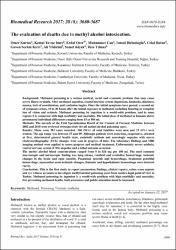| dc.description.abstract | Background: Methanol poisoning is a serious medical, social and economic problem that may cause severe illness or death. After methanol ingestion, central nervous system depression, headache, dizziness, nausea, lack of coordination, and confusion begins. Once the initial symptoms have passed, a second set of symptoms arises, 10 to 30 hours after the initial exposure to methanol, including blurring or complete loss of vision and acidosis. Methanol poisoning by ingestion is a world-wide problem, and in some regions it is connected with high morbidity and mortality. The lethal dose of methanol in humans shows pronounced individual differences ranging from 15 to 500 ml.
Methods: The records of the First Specialization Board of the Council of Forensic Medicine between 2002 and 2010 were reviewed retrospectively for all methyl alcohol poisoning cases.
Results: There were 383 cases recorded. 360 (94%) of total fatalities were men and 23 (6%) were women. The age range was between 17 and 89. Although patients were conscious, cooperative, oriented at first, deteriorated general health state, metabolic acidosis and neurologic sequelae with severe electrocardiographic (ECG) changes were seen in progress of time. The laboratory findings and MRI imaging method were applied to assess progress and medical treatment. Unfortunately severe acidosis, central nervous system (CNS) sequelae and a lethal outcome occurred. The methyl alcohol blood concentrations ranged from 0 to 826 mg per 100 ml. The most common macroscopic and microscopic finding was lung edema, cerebral and cerebellar hemorrhage, ischemic changes in the brain and optic neuritis. Putaminal necrosis and hemorrhage, brainstem petechial hemorrhage, myocardial acute ischemic changes, thalamic and hypothalamic hemorrhage were detected rarely.
Conclusions: This is the first study to report postmortem findings, clinical reports, crime scene reports and eye witness accounts to investigate methyl alcohol poisoning cases from medico-legal point of view in Turkey. Methanol poisoning by ingestion is a world-wide problem with high morbidity and mortality. For preventing methanol deaths, both awareness and public education must be increased. | en_US |


















